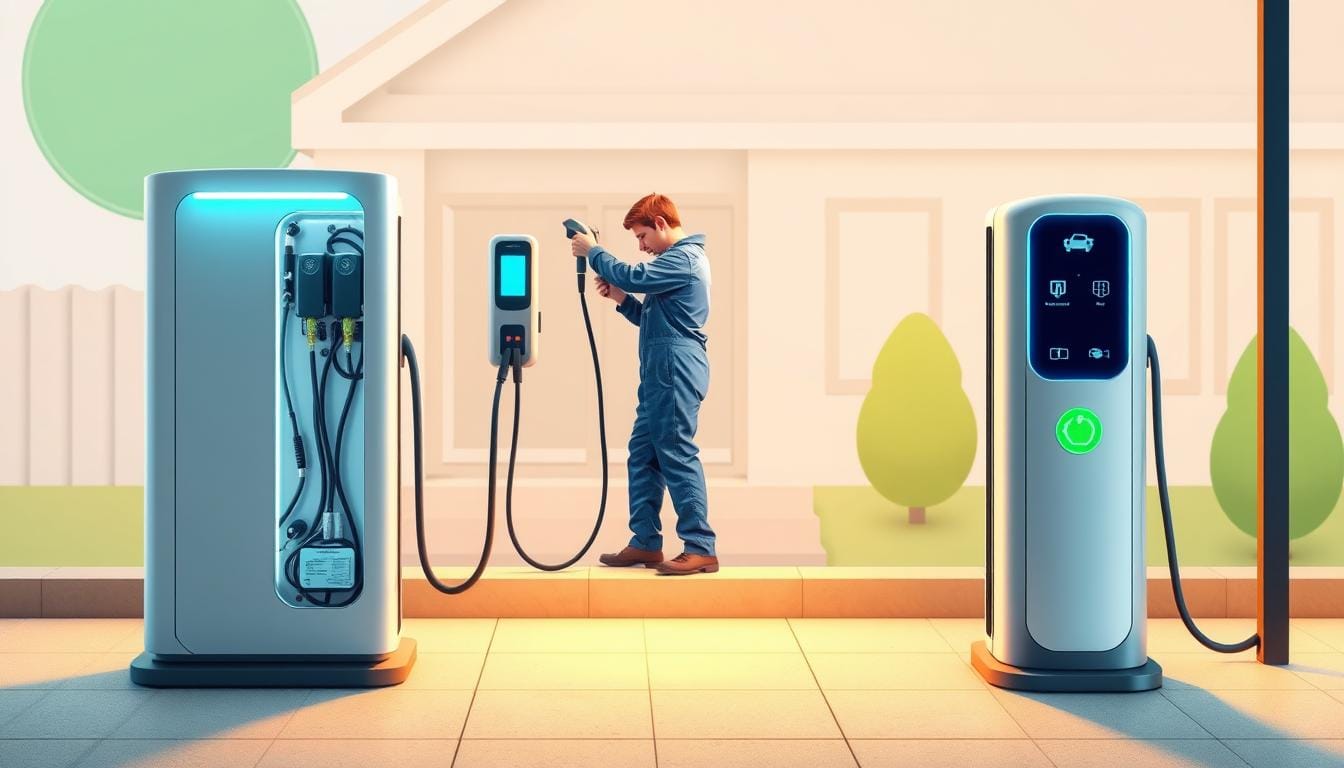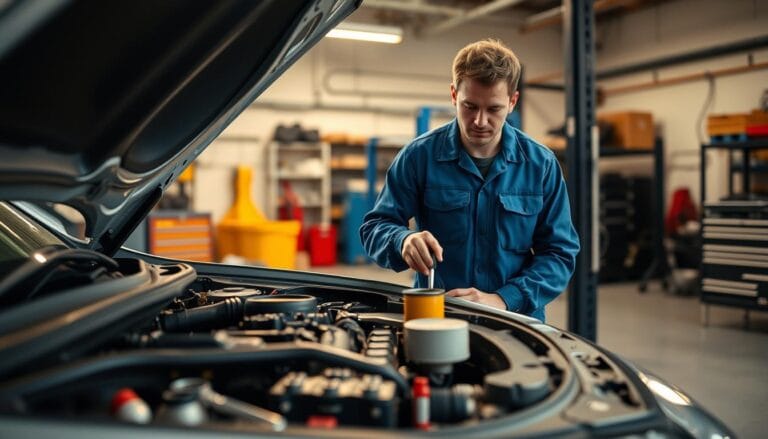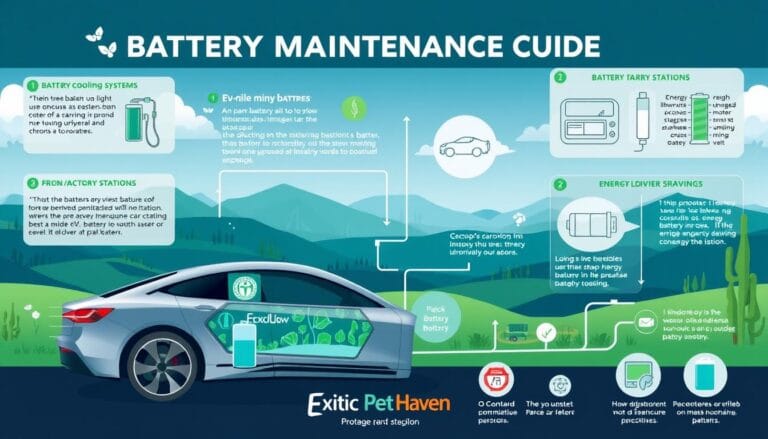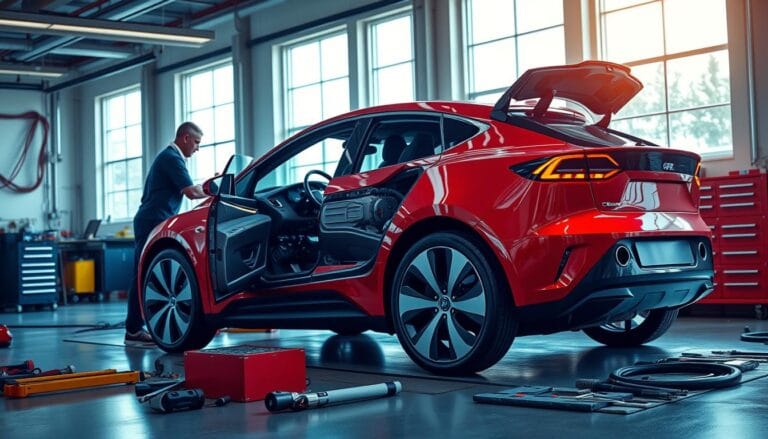EV Charger Maintenance: Home Station Longevity Tips
As an electric vehicle owner, you’ve made a smart choice for cleaner transport. But have you thought about how important EV charger maintenance is? Your home charger is key to your car’s performance and life.
Electric Vehicle Charger Repair is about avoiding problems, not just fixing them. Taking care of your charger saves time, money, and stress. Regular upkeep keeps your charger reliable, efficient, and safe.
EV Charger Maintenance is easier than you think. With a few steps and regular care, your charger can last longer and charge better for years.
Table of Contents
Understanding the Importance of EV Charger Maintenance
Keeping your electric vehicle (EV) charging station in good shape is key. It’s not just about cleaning. It’s about making sure your charger works well for a long time.
EV owners can make their chargers last longer with regular care. A well-kept charger can work for 10-15 years. This makes keeping up with maintenance a wise choice.
Key Benefits of Regular Maintenance
- Extends charging equipment lifespan
- Prevents unexpected system failures
- Ensures optimal charging performance
- Reduces long-term repair costs
- Maintains electrical safety standards
Potential Risks of Neglecting Charger Care
Charging Infrastructure Maintenance is a must. If you ignore your EV charger, you could face big problems:
- Safety Hazards: Damaged parts can be dangerous
- Reduced Efficiency: Bad maintenance slows down charging
- Expensive Repairs: Small issues can turn into big ones
- Equipment Failure: Your charger might stop working completely
It’s smart to have a pro check your charger every year. Doing weekly checks can help spot problems early. By taking care of your charger, you keep your car and charging system safe.
Inspecting Your EV Charger Regularly
Keeping your electric vehicle charger in good shape is key. Regular checks are vital for its performance and safety. A routine inspection can spot problems early, saving you money and hassle.
Regular checks can spot issues early, saving up to 30% on maintenance. Experts say a detailed check is best for your charging station’s health.
Visual Inspection Checklist
- Check cable integrity for any signs of fraying or damage
- Examine connector points for corrosion or wear
- Inspect electrical connections for looseness
- Look for physical cracks in the charger housing
- Verify cable insulation remains intact
Signs of Wear and Tear to Look For
When you inspect your charger, watch for these warning signs:
- Burn marks showing overheating
- Exposed or damaged wiring
- Visible cracks in connectors or housing
- Signs of moisture intrusion
- Unusual discoloration of components
Spotting issues early can avoid bigger electrical problems and keep your car’s charging system safe.
Regular safety checks can make your charger last longer and work better. Just a few minutes a month can boost your charger’s performance by up to 40% and avoid sudden failures.
Cleaning Your EV Charger: Best Practices
Keeping your electric vehicle charger in top shape is key for its performance and life. With over 1.2 million EVs sold in the U.S. in 2023, it’s more important than ever for owners to maintain their chargers.
Regular cleaning of your charging station can stop problems before they start. It can also make your charger last longer. Studies show that well-maintained charging equipment can cut down overheating by up to 40%.
Essential Tools for Cleaning
- Microfiber cloths
- Mild, non-conductive cleaning solution
- Soft-bristled brush
- Compressed air
- Protective gloves
Step-by-Step Cleaning Guide
- Power Down: Always disconnect the charger from the power source before cleaning
- Inspect the charging equipment for any visible damage
- Use compressed air to remove dust and debris from connectors
- Gently wipe surfaces with a microfiber cloth
- Clean connectors carefully to ensure secure attachment
- Allow all components to dry completely before reconnecting
Charging equipment servicing needs careful attention. Regular cleaning can stop up to 30% of charger malfunctions. It can also extend the charger’s life by about 20%. Always clean in a dry place to avoid electrical problems caused by moisture.
Pro Tip: Clean your EV charger at least once a month to maintain optimal performance and prevent electrical issues.
Keeping The Charging Cable in Good Condition
Your electric vehicle’s charging cable is very important. It needs careful care to last longer. This can save you money on repairs.
EV charger maintenance is not just about the station. The cable also needs attention. It can get damaged easily and wear out fast.
Proper Handling Techniques
Here are key ways to protect your charging cable:
- Always handle the cable by its plug, not the cord
- Avoid dragging the cable on rough surfaces
- Prevent sharp bends or kinks that can damage internal wires
- Never run over the cable with your vehicle
“A well-maintained charging cable can save you hundreds in replacement costs.”
Storage Solutions to Prevent Damage
Storing your cable right is key for EV charger maintenance. Here are some tips:
- Use wall-mounted cable organizers
- Invest in retractable cable management systems
- Keep cables off ground to prevent tripping hazards
- Store in a dry, temperature-controlled environment
In cold weather, be extra careful. Ice and snow can cause cables to expand and contract, potentially weakening their structure. Regular checks can spot wear early, saving on repairs.
By following these simple steps, you’ll make your charging cable last longer. This ensures your electric vehicle charges reliably.
Firmware Updates: Why They Matter
Keeping your electric vehicle charger’s firmware up to date is key for top-notch Charging Infrastructure Maintenance. Software updates are essential for your EV charger to work its best. They fix bugs and make the charger more efficient.
When you face EV Charger Troubleshooting, remember the role of firmware updates. Modern charging stations need constant software updates.
How to Check for Updates
Many EV charger makers offer updates through different ways:
- Mobile app notifications
- Manufacturer’s website
- Direct email communications
- Dashboard notifications on smart charging platforms
“Regular firmware updates are your first line of defense in maintaining charging infrastructure efficiency.” – EV Charging Technology Experts
Steps to Update Your Charger’s Software
Here’s how to update your charger smoothly:
- Check current firmware version
- Download official update from manufacturer
- Ensure stable internet connection
- Follow manufacturer’s specific installation instructions
- Verify successful update completion
The EV charging market is set to boom from 4 million to 35 million chargers by 2030. Keeping your charger’s firmware up to date is vital. It ensures your investment stays protected and efficient.
Overcurrent and Overvoltage Protection
Electric vehicle charging safety is key. With over 17 million EVs expected to be sold by 2023, keeping your charger safe is essential. This ensures your vehicle charges without a hitch.

Protecting your charger involves several important steps. Regular servicing is vital to avoid electrical risks. These risks can harm your EV’s charging system.
Understanding Electrical Basics
EV charging systems face many electrical challenges. These need to be managed well:
- Overcurrent risks can cause severe damage to charging infrastructure
- Voltage fluctuations may compromise charging efficiency
- High-temperature conditions increase electrical system stress
Essential Safety Protection Strategies
Keep your EV charging safe with these features:
- Install a ground fault interrupter (GFI) to prevent electrocution
- Use surge protection devices (SPDs) to manage voltage spikes
- Implement temperature and current sensors for continuous monitoring
The automotive environment represents one of the most demanding electronic ecosystems, requiring robust protection solutions.
Experts suggest using advanced protection like SIDACtor and MOV combinations. These can greatly reduce electrical damage risks. They ensure your EV charges safely and efficiently.
Environmental Factors Affecting EV Charger Lifespan
Electric vehicle charging stations face unique challenges from environmental conditions. Your EV charging infrastructure maintenance depends on understanding how different weather elements impact charging performance and equipment durability.
Extreme temperatures pose significant risks to your EV charging station upkeep. Environments with dramatic seasonal variations can accelerate equipment wear and reduce overall charging efficiency.
Temperature Impact on Charging Performance
Temperature dramatically influences EV charging capabilities. Research shows that both cold and hot climates create unique challenges for charging infrastructure:
- Cold temperatures increase internal battery resistance
- High temperatures can cause battery overheating
- Extreme conditions reduce charging efficiency
Protecting Your Charging Equipment
Implementing protective strategies can significantly extend your charging station’s lifespan. Consider these protective measures:
- Install weather-resistant charging station covers
- Choose sheltered installation locations
- Use temperature-regulated charging equipment
| Temperature Range | Potential Impact | Recommended Action |
|---|---|---|
| Below 32°F | Reduced charging speed | Use heated charging stations |
| Above 95°F | Risk of overheating | Provide shade and ventilation |
By understanding environmental challenges and implementing proactive maintenance strategies, you can protect your EV charging infrastructure from damage. This ensures optimal performance across varying conditions.
Troubleshooting Common EV Charger Issues
Electric vehicle owners sometimes face charging problems. Knowing how to fix these issues can save time and money. It also helps avoid damage to your charging equipment.
Charging issues are more common than you might think. 21% of charging sessions reported some form of issue. This makes it important for EV owners to know how to repair their chargers.
Identifying Common Problems
There are several common EV charger issues:
- Screen or display malfunctions (76% of reported problems)
- Hardware connection failures (36% of issues)
- Charging power inconsistencies (15% of problems)
- Payment system errors (23% of reported challenges)
DIY vs. Professional Repairs
Not all EV charger issues need a professional. Some can be fixed with simple troubleshooting. Others require expert Electric Vehicle Charger Repair services.
Pro Tip: Always prioritize safety when attempting any electrical repairs.
When choosing between DIY and professional repair, consider these factors:
- Complexity of the issue
- Your technical expertise
- Warranty considerations
- Potential risk of further damage
Experts suggest regular maintenance to avoid charging problems. Keeping software updated can solve about 70% of software-related issues. This makes regular care key for reliable EV charging.
Must-Have Tools for EV Charger Maintenance
Keeping your EV charger in good shape needs the right tools. These tools help you maintain your charging equipment safely and efficiently. This is key for your electric vehicle’s power source.
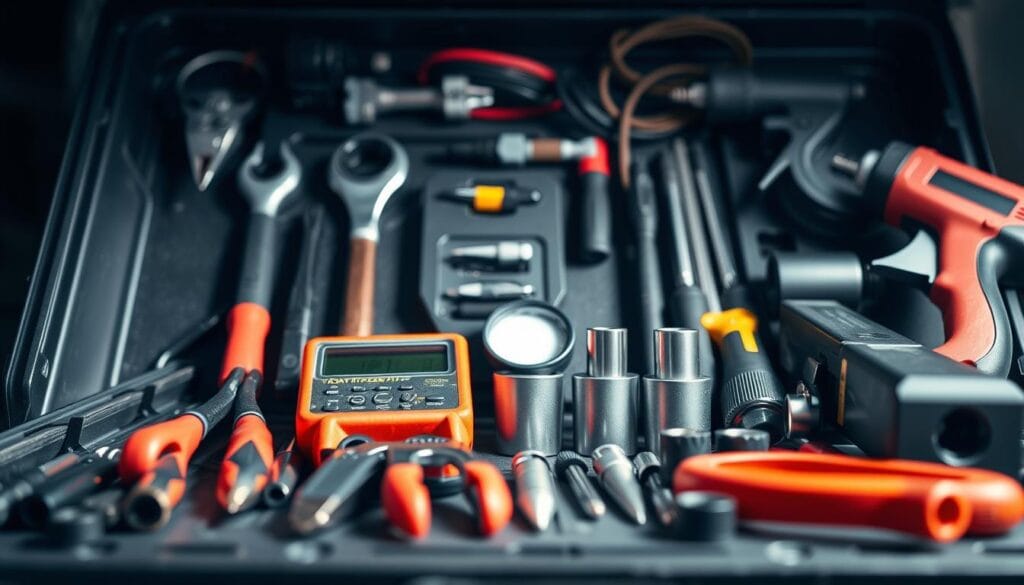
Every EV owner should have a special toolkit for EV Charger Maintenance. These tools are vital for basic checks and keeping your charging station working well.
Essential Tools for Home Maintenance
- Multimeter: For checking electrical connections and voltage
- Insulated screwdrivers with rubber handles
- Microfiber cleaning cloths
- Electrical contact cleaner
- Protective safety gloves
- Safety goggles
Where to Purchase Maintenance Tools
You can find these specialized tools at several locations:
- Auto parts stores
- Online marketplaces like Amazon
- Specialty electrical supply stores
- Local hardware stores
When choosing tools, focus on quality and safety. Even though professional-grade tools might cost more, they protect your expensive charging system from damage.
Invest in proper tools to protect your EV charging investment and ensure long-term performance.
Planning for Long-Term Charger Performance
Keeping your electric vehicle (EV) charging station in top shape is key. It ensures your charging system works well and lasts long. Proper upkeep is vital for a reliable and efficient charging setup.
Having a solid maintenance plan stops unexpected failures and extends your charger’s life. Charger Network Management begins with knowing which parts need regular checks.
Importance of Regular Check-Ups
Regular maintenance is essential for a reliable EV charging system. Your charging station faces constant electrical stress. So, regular inspections are a must.
Here are the main reasons for maintenance:
- Prevent electrical failures
- Spot wear and tear early
- Keep charging performance steady
- Extend your charging station’s life
Recommended Maintenance Schedule
Make a maintenance plan that fits your charging needs. Here are suggested intervals for keeping your EV charging station in great shape:
| Frequency | Maintenance Tasks |
|---|---|
| Weekly | Visual check, cable inspection, cleaning |
| Monthly | Electrical connection review, software update check |
| Quarterly | Comprehensive system diagnostic, performance check |
| Annually | Professional technical check, full system review |
Being proactive with Charger Network Management cuts down on unexpected downtime. It keeps your charging at its best. Keeping track of your maintenance helps spot issues before they get big.
When to Call a Professional for Maintenance
Not every electric vehicle charger problem can be fixed by yourself. Some issues need a pro to keep you safe and your charger working right. Knowing when to get help can avoid big costs and unexpected problems.
Signs You Need Expert Help
Some signs mean it’s time to call a pro for EV Charger Safety Checks. Look out for these important warning signs:
- Persistent error messages on your charging station
- Significant reduction in charging speed
- Visible physical damage to cables or charging unit
- Unusual sounds or electrical burning smell
- Inconsistent power output
Choosing the Right Technician
Not all technicians are the same when it comes to electric vehicle charger maintenance. Think about these important factors when picking a pro:
- Certification in EV charging system repairs
- Experience with your specific charger model
- Positive customer reviews and references
- Up-to-date knowledge of current EV technologies
- Transparent pricing and warranty options
Regular maintenance can stop unexpected failures. Annual professional inspections are recommended to ensure your charging station operates at peak efficiency. These check-ups can spot problems early, saving you from costly repairs and keeping your electric vehicle investment safe.
The Future of EV Charger Technology
Electric vehicle charging technology is changing fast. By 2030, we’ll see huge changes with 240 million electric cars on the road. Keeping EV charging systems in top shape will be key.
Wireless charging is set to change how we charge our cars. It means no more plugs and easier maintenance. New tech like charging robots and vehicle-to-grid systems are opening up new options for car owners. The U.S. will need 2.8 million charging ports, showing the big leap in tech.
Smart monitoring software is now a must for charging stations. It helps find and fix problems quickly. Faster charging times are coming, with some methods charging 80% in under 10 minutes. Keeping up with these new techs will be important for your charging setup.
The future of EV charging is also about being green. We’re seeing more solar-powered stations and smart grid connections. With $300 billion in investments by 2030, expect better, greener, and more efficient charging options for electric cars.

